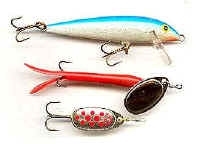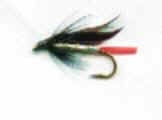Fishing Advice
Generally the Tâf is a small but noted river in West Wales which has good runs of seatrout and salmon as well as a healthy population of brown trout. Worming, spinning and fly fishing are all permitted on the river. The season runs from 1st April to 7th October.
We offer all our guests free fishing along our 2.5 mile stretch of river, in places on both sides.
By law, you must obtain a rod fishing licence from the government, this can be done online or over the phone.
They do 1-day, 8-day and 12 months licences. Children ages 13 -16 can obtain a licence for free.
Fishing in waders, (if you have them) is advised as there are a number of trees along the river bank.
These notes will provide you with general information on the river; catches, river conditions, tactics and successful flies and spinners.
Catches
SEATROUT: (Also called Sewin):
The majority of the seatrout caught on the Tâf weigh between 1lb and 3lb but much bigger fish run the river.
Each season several fish over 4lb in weight are caught on the fly. The larger fish run from May onwards while the smaller fish appear in July.

The 6lb12oz seatrout pictured here was caught on a Sweeny Todd.

The fish was caught in August at 10.15p.m.in low water conditions on a floating line.
SALMON:
There is an early run of salmon in April and May but under current legislation, any salmon caught before 16th June must be released. There is a further run in September and early October. The majority of salmon caught weigh between 6lb and 10lb but occasionally fish of over 14lb are taken.
TROUT:
While the vast majority of the brown trout are on the small side, each season fish of over 1lb are taken by all methods. For anglers who prefer still-water trout fishing a number of waters are available such as Llysyfran Reservoir.
River Conditions, Tactics, Spinners & Flies
GENERAL
The Tâf is a small spate river which has an interesting mixture of deep pools, riffles and runs. There are areas of clear bank which allow casting but there are also areas of bank lined with trees and bushes which provide more challenging fishing. Traditionally the river is fished best three days after heavy rain but following the implementation of flood prevention schemes in the Whitland area in recent years, water levels now drop much more quickly and the river is best fished the day after rain.
Tactics
WORMING:
When there is a good flow of water in the river, fishing with a “bunch” of worms (usually 2/3 brandlings or lobworms) is an effective method of catching salmon and seatrout. The weights used should be light enough to allow the worms to trundle along the river bed. Most anglers use lines of between 10 to 15 lb breaking strain. In lower water conditions sea trout can be taken from runs by fishing a single worm on lighter lines of 6-8lb.
SPINNING:

If the water is very coloured a Yellow Flying C 15g. or a 9 or 7 Gold Fluorescent Red Rapala or Red Clown Rapala is recommended for salmon and seatrout. When the water colour is less intense a Red Flying C or a Blue Rapala should prove more successful. In clearer water, the Rainbow Rapala or Brown Trout Rapala is more effective. Many local anglers use the Mepps Aglia Comet Silver with Red Spots or Silver with Blue Spots when spinning for seatrout. Lines of between 10 to 15 lb are usually employed. Below is a selection of spinners used on the Taf for salmon and seatrout: Rapala, Flying C and Mepps.
FLY FISHING:
The majority of anglers find that intermediate lines suit their general needs best when flyfishing for seatrout and salmon. Floating lines are used in low water conditions while sinking lines tend only to be used in April or early May to search out the deeper pools. Most situations can be catered for with leader lengths of 3-6ft. It is recommended that a breaking strain of at least 6lb be used because of the possibility of hooking large fish and the need to steer smaller fish away from tree roots; many local anglers use leaders of 8-10lb. Size 8 is the normal hook size used for evening fishing for seatrout with smaller sizes being used for clear water daytime visits. Sweeny Todd, Peter Ross and Butcher are popular evening patterns but seatrout are occasionally taken in the daytime from fast runs on size 14 Dunkeld or Mallard and Claret by anglers fishing for trout. March Brown, Silver March Brown and Greenwell’s Glory are popular early-season flies for trout, while the seatrout flies mentioned above will, in sizes 10 to 14, also take trout. The majority of Taf salmon are caught on worm or spinner but some success has been achieved with Silver Stoat and Dovey Black and Orange..
Flies used on the Tâf

SILVER STOAT:
Hook: single or double 6-8. Tail: golden pheasant topping. Body: flat silver tinsel. Rib: silver wire. Hackle: black hen. Wing: black tip of stoat’s tail or black bucktail.

SILVER STOAT:
Hook: single or double 6-8. Tail: golden pheasant topping. Body: flat silver tinsel. Rib: silver wire. Hackle: black hen. Wing: black tip of stoat’s tail or black bucktail.
FOR SEATROUT
The patterns which have proved consistently successful on the Tâf for evening fly fishing are detailed below

SWEENY TODD:
Hook: long shank 8/10. Body: black floss. Rib: silver oval tinsel. Thorax: magenta floss. Hackle: magenta/red hen. Wing: black squirrel tail.

PETER ROSS:
Hook: standard 8/10.Tail: golden pheasant tippets. Body: front half red seal fur substitute; rear half flat silver tinsel. Rib : oval silver tinsel. Hackle: black hen. Wing: teal flank feather.

OXLURE SECRET WEAPON:
Hook: longshank 10 and treble 14. Tag: fluorescent green wool. Body: flat silver tinsel. Rib: silver wire. Hackle: blue hen. Wing: black bucktail.

BUTCHER:
Hook: standard 8/10. Tail: red ibis substitute. Body: flat silver tinsel. Rib: silver wire. Hackle: black hen. Wing: blue section from mallard wing.

DUNKELD:
Hook: standard 8-14. Tail: golden pheasant topping. Body: flat gold tinsel. Rib: gold wire. Hackle: hot orange cock. Wing: bronze mallard. Cheeks (optional) jungle cock eyes.

MALLARD AND CLARET:
Hook: standard 8-14. Tail: golden pheasant tippets. Body: claret seal’s fur substitute. Rib: gold wire. Hackle: ginger or claret hen. Wing: bronze mallard.
